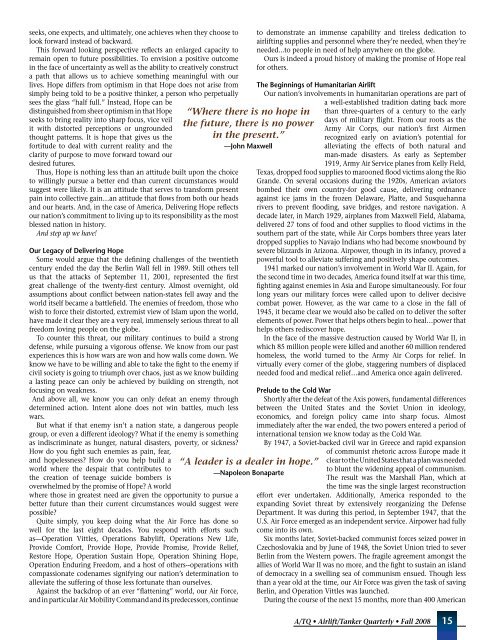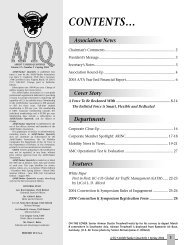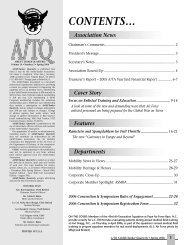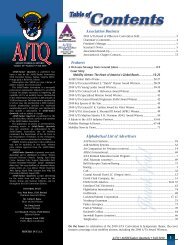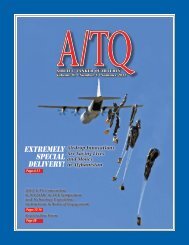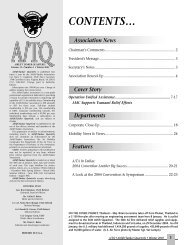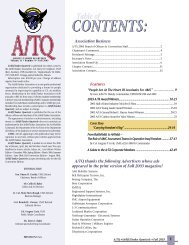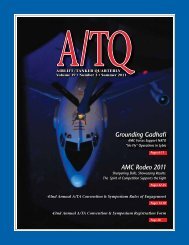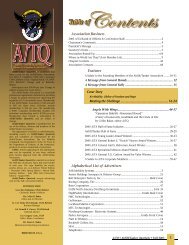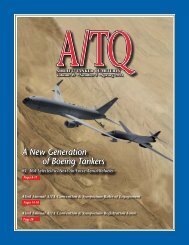Contents - Airlift/Tanker Association
Contents - Airlift/Tanker Association
Contents - Airlift/Tanker Association
You also want an ePaper? Increase the reach of your titles
YUMPU automatically turns print PDFs into web optimized ePapers that Google loves.
seeks, one expects, and ultimately, one achieves when they choose to<br />
look forward instead of backward.<br />
This forward looking perspective reflects an enlarged capacity to<br />
remain open to future possibilities. To envision a positive outcome<br />
in the face of uncertainty as well as the ability to creatively construct<br />
a path that allows us to achieve something meaningful with our<br />
lives. Hope differs from optimism in that Hope does not arise from<br />
simply being told to be a positive thinker, a person who perpetually<br />
sees the glass “half full.” Instead, Hope can be<br />
distinguished from sheer optimism in that Hope<br />
seeks to bring reality into sharp focus, vice veil<br />
it with distorted perceptions or ungrounded<br />
thought patterns. It is hope that gives us the<br />
fortitude to deal with current reality and the<br />
clarity of purpose to move forward toward our<br />
desired futures.<br />
Thus, Hope is nothing less than an attitude built upon the choice<br />
to willingly pursue a better end than current circumstances would<br />
suggest were likely. It is an attitude that serves to transform present<br />
pain into collective gain…an attitude that flows from both our heads<br />
and our hearts. And, in the case of America, Delivering Hope reflects<br />
our nation’s commitment to living up to its responsibility as the most<br />
blessed nation in history.<br />
And step up we have!<br />
Our Legacy of Delivering Hope<br />
Some would argue that the defining challenges of the twentieth<br />
century ended the day the Berlin Wall fell in 1989. Still others tell<br />
us that the attacks of September 11, 2001, represented the first<br />
great challenge of the twenty-first century. Almost overnight, old<br />
assumptions about conflict between nation-states fell away and the<br />
world itself became a battlefield. The enemies of freedom, those who<br />
wish to force their distorted, extremist view of Islam upon the world,<br />
have made it clear they are a very real, immensely serious threat to all<br />
freedom loving people on the globe.<br />
To counter this threat, our military continues to build a strong<br />
defense, while pursuing a vigorous offense. We know from our past<br />
experiences this is how wars are won and how walls come down. We<br />
know we have to be willing and able to take the fight to the enemy if<br />
civil society is going to triumph over chaos, just as we know building<br />
a lasting peace can only be achieved by building on strength, not<br />
focusing on weakness.<br />
And above all, we know you can only defeat an enemy through<br />
determined action. Intent alone does not win battles, much less<br />
wars.<br />
But what if that enemy isn’t a nation state, a dangerous people<br />
group, or even a different ideology? What if the enemy is something<br />
as indiscriminate as hunger, natural disasters, poverty, or sickness?<br />
How do you fight such enemies as pain, fear,<br />
and hopelessness? How do you help build a<br />
world where the despair that contributes to<br />
the creation of teenage suicide bombers is<br />
overwhelmed by the promise of Hope? A world<br />
where those in greatest need are given the opportunity to pursue a<br />
better future than their current circumstances would suggest were<br />
possible?<br />
Quite simply, you keep doing what the Air Force has done so<br />
well for the last eight decades. You respond with efforts such<br />
as—Operation Vittles, Operations Babylift, Operations New Life,<br />
Provide Comfort, Provide Hope, Provide Promise, Provide Relief,<br />
Restore Hope, Operation Sustain Hope, Operation Shining Hope,<br />
Operation Enduring Freedom, and a host of others--operations with<br />
compassionate codenames signifying our nation’s determination to<br />
alleviate the suffering of those less fortunate than ourselves.<br />
Against the backdrop of an ever “flattening” world, our Air Force,<br />
and in particular Air Mobility Command and its predecessors, continue<br />
“Where there is no hope in<br />
the future, there is no power<br />
in the present.”<br />
—John Maxwell<br />
“A leader is a dealer in hope.”<br />
—Napoleon Bonaparte<br />
to demonstrate an immense capability and tireless dedication to<br />
airlifting supplies and personnel where they’re needed, when they’re<br />
needed...to people in need of help anywhere on the globe.<br />
Ours is indeed a proud history of making the promise of Hope real<br />
for others.<br />
The Beginnings of Humanitarian <strong>Airlift</strong><br />
Our nation’s involvements in humanitarian operations are part of<br />
a well-established tradition dating back more<br />
than three-quarters of a century to the early<br />
days of military flight. From our roots as the<br />
Army Air Corps, our nation’s first Airmen<br />
recognized early on aviation’s potential for<br />
alleviating the effects of both natural and<br />
man-made disasters. As early as September<br />
1919, Army Air Service planes from Kelly Field,<br />
Texas, dropped food supplies to marooned flood victims along the Rio<br />
Grande. On several occasions during the 1920s, American aviators<br />
bombed their own country-for good cause, delivering ordnance<br />
against ice jams in the frozen Delaware, Platte, and Susquehanna<br />
rivers to prevent flooding, save bridges, and restore navigation. A<br />
decade later, in March 1929, airplanes from Maxwell Field, Alabama,<br />
delivered 27 tons of food and other supplies to flood victims in the<br />
southern part of the state, while Air Corps bombers three years later<br />
dropped supplies to Navajo Indians who had become snowbound by<br />
severe blizzards in Arizona. Airpower, though in its infancy, proved a<br />
powerful tool to alleviate suffering and positively shape outcomes.<br />
1941 marked our nation’s involvement in World War II. Again, for<br />
the second time in two decades, America found itself at war this time,<br />
fighting against enemies in Asia and Europe simultaneously. For four<br />
long years our military forces were called upon to deliver decisive<br />
combat power. However, as the war came to a close in the fall of<br />
1945, it became clear we would also be called on to deliver the softer<br />
elements of power. Power that helps others begin to heal…power that<br />
helps others rediscover hope.<br />
In the face of the massive destruction caused by World War II, in<br />
which 85 million people were killed and another 60 million rendered<br />
homeless, the world turned to the Army Air Corps for relief. In<br />
virtually every corner of the globe, staggering numbers of displaced<br />
needed food and medical relief…and America once again delivered.<br />
Prelude to the Cold War<br />
Shortly after the defeat of the Axis powers, fundamental differences<br />
between the United States and the Soviet Union in ideology,<br />
economics, and foreign policy came into sharp focus. Almost<br />
immediately after the war ended, the two powers entered a period of<br />
international tension we know today as the Cold War.<br />
By 1947, a Soviet-backed civil war in Greece and rapid expansion<br />
of communist rhetoric across Europe made it<br />
clear to the United States that a plan was needed<br />
to blunt the widening appeal of communism.<br />
The result was the Marshall Plan, which at<br />
the time was the single largest reconstruction<br />
effort ever undertaken. Additionally, America responded to the<br />
expanding Soviet threat by extensively reorganizing the Defense<br />
Department. It was during this period, in September 1947, that the<br />
U.S. Air Force emerged as an independent service. Airpower had fully<br />
come into its own.<br />
Six months later, Soviet-backed communist forces seized power in<br />
Czechoslovakia and by June of 1948, the Soviet Union tried to sever<br />
Berlin from the Western powers. The fragile agreement amongst the<br />
allies of World War II was no more, and the fight to sustain an island<br />
of democracy in a swelling sea of communism ensued. Though less<br />
than a year old at the time, our Air Force was given the task of saving<br />
Berlin, and Operation Vittles was launched.<br />
During the course of the next 15 months, more than 400 American<br />
A/TQ • <strong>Airlift</strong>/<strong>Tanker</strong> Quarterly • Fall 2008<br />
15


